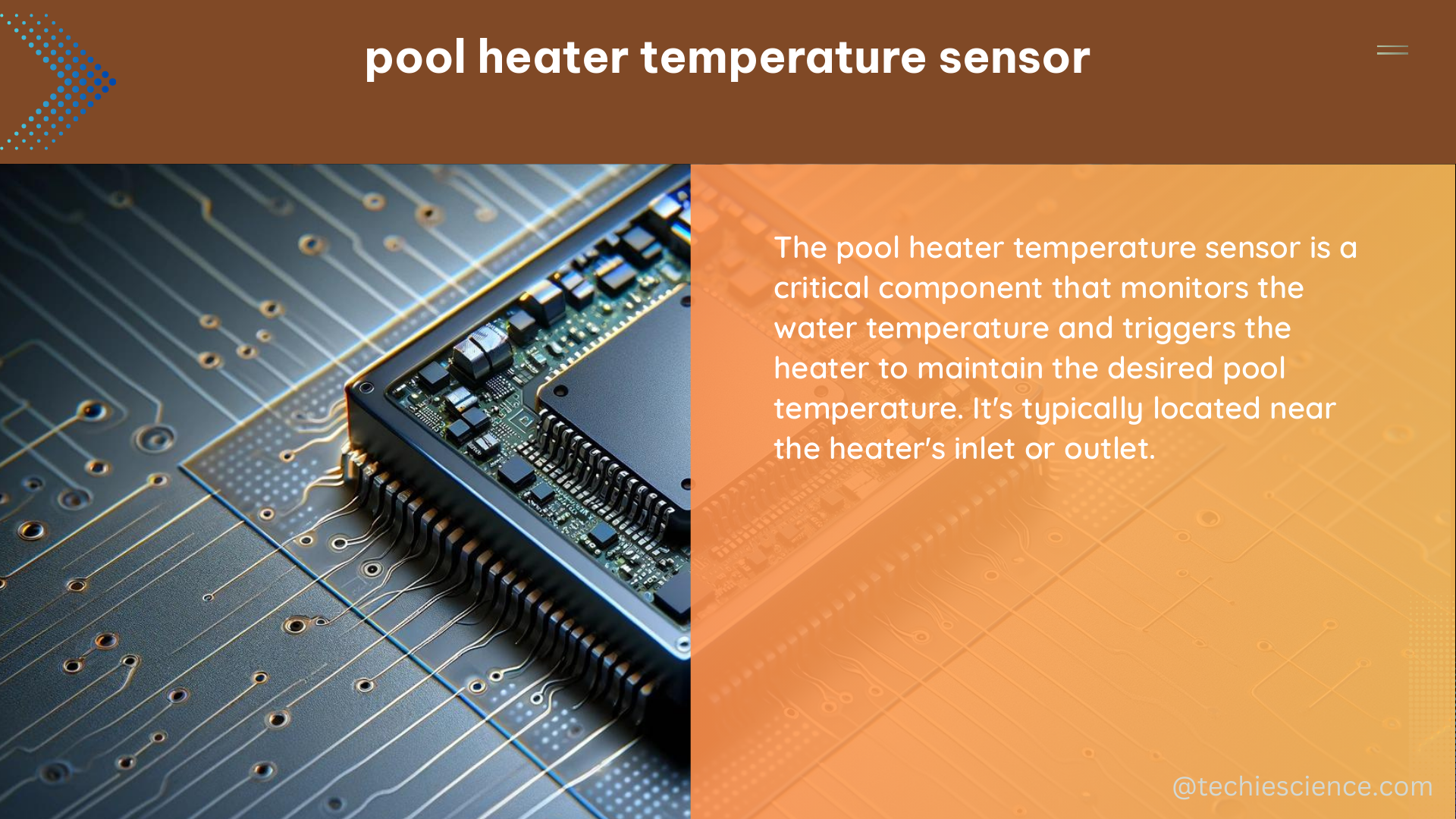The pool heater temperature sensor is a critical component in maintaining the desired water temperature in a swimming pool. This sensor, typically a two-wire device, is often a thermistor – a type of resistor that changes resistance with temperature. Understanding the intricacies of this sensor and its functionality is essential for effective pool heating system management.
Understanding the Thermistor Principle
Thermistors are temperature-sensitive resistors that exhibit a significant change in resistance with a relatively small change in temperature. The relationship between resistance and temperature is typically non-linear, following an exponential curve known as a Negative Temperature Coefficient (NTC) characteristic.
A common NTC thermistor used in pool heater temperature sensors has a resistance of 10kΩ at 25°C (77°F). As the temperature decreases, the resistance increases exponentially. For example, at 15°C (59°F), the resistance might be around 20kΩ, while at 35°C (95°F), the resistance could drop to approximately 5kΩ.
Measuring the Sensor’s Resistance

To test the functionality of the pool heater temperature sensor, you can use a digital multimeter set to the Ohms (Ω) setting. By placing the multimeter’s probes on the two-wire sensor terminals, you can observe the resistance variation as you change the probe temperature.
Here’s a table showing the approximate resistance values for a typical NTC thermistor used in pool heater temperature sensors:
| Temperature (°C) | Resistance (kΩ) |
|---|---|
| 15 | 20 |
| 20 | 15 |
| 25 | 10 |
| 30 | 7.5 |
| 35 | 5 |
It’s important to note that the exact resistance values may vary depending on the specific thermistor used in the pool heater temperature sensor.
Sensor Placement and Accuracy
The location of the pool heater temperature sensor can significantly impact the accuracy of the temperature readings. If the sensor is installed in a location that does not accurately represent the water temperature, such as in direct sunlight along the pipe between the pump and the filter, it can lead to inaccurate readings.
To ensure accurate temperature measurements, the sensor should be placed in a location that is representative of the overall pool water temperature. This could be, for example, in the return line from the pool, where the water has had a chance to mix and reach a more uniform temperature.
Calibrating the Sensor
If the pool heater temperature sensor is not providing accurate readings, you may need to calibrate it. This process involves comparing the sensor’s readings to a known, accurate temperature source, such as a digital thermometer placed directly in the pool water.
To calibrate the sensor:
- Measure the pool water temperature using a reliable digital thermometer.
- Measure the resistance of the pool heater temperature sensor using a multimeter.
- Refer to the sensor’s resistance-temperature characteristics to determine the expected temperature based on the measured resistance.
- Compare the expected temperature to the actual water temperature measured by the digital thermometer.
- If there is a discrepancy, adjust the pool heater’s temperature settings or, if possible, recalibrate the sensor’s internal settings to match the actual water temperature.
Troubleshooting Common Issues
If the pool heater is not maintaining the desired water temperature, there are a few common issues to consider related to the temperature sensor:
- Sensor Failure: If the sensor is not responding or providing erratic readings, it may be faulty and need replacement.
- Sensor Placement: As mentioned earlier, the sensor’s location can significantly impact the accuracy of the readings. Ensure the sensor is placed in a representative location.
- Sensor Calibration: If the sensor is providing inaccurate readings, it may need to be recalibrated to match the actual water temperature.
- Wiring Issues: Check the sensor’s wiring for any damage or loose connections, as this can also lead to inaccurate readings.
Upgrading or Replacing the Sensor
In some cases, you may want to consider upgrading or replacing the pool heater temperature sensor. This could be due to the sensor’s age, the need for more accurate temperature control, or the desire to integrate the sensor with a more advanced pool automation system.
When selecting a replacement sensor, consider the following factors:
- Sensor Type: Ensure the new sensor is compatible with your pool heater’s control system, typically a thermistor or a PT (Platinum) sensor.
- Resistance Range: Match the resistance range of the new sensor to the expected temperature range in your pool.
- Mounting and Wiring: Ensure the new sensor can be easily installed in the same location as the old one, with compatible wiring connections.
- Accuracy and Responsiveness: Choose a sensor with the desired level of accuracy and fast response time to changes in water temperature.
By understanding the intricacies of pool heater temperature sensors, you can effectively maintain, troubleshoot, and upgrade your pool’s heating system to ensure optimal performance and energy efficiency.
References:
- Tapping into existing two-wire temperature sensor from pool heating system
- Temperature sensor for pool heater
- Thermistor Basics: How Thermistors Work
- Resistance-Temperature Characteristics of Thermistors

The lambdageeks.com Core SME Team is a group of experienced subject matter experts from diverse scientific and technical fields including Physics, Chemistry, Technology,Electronics & Electrical Engineering, Automotive, Mechanical Engineering. Our team collaborates to create high-quality, well-researched articles on a wide range of science and technology topics for the lambdageeks.com website.
All Our Senior SME are having more than 7 Years of experience in the respective fields . They are either Working Industry Professionals or assocaited With different Universities. Refer Our Authors Page to get to know About our Core SMEs.